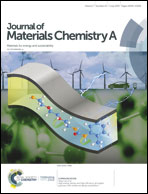Proton delivery through a dynamic 3D H-bond network constructed from dense hydroxyls for advanced ion-selective membranes†
Abstract
An advanced ion-selective membrane containing a dynamic hydroxyl-based 3D H-bond network is first proposed for improved efficiencies and stability in flow battery applications. The 3D H-bond network structure is constructed by the nanoscale aggregation of hydrophilic dense-hydroxyl side chains anchored to hydrophobic polybenzimidazole. This unique dynamic H-bond network creates proton transport highways as well as vanadium permeation barriers across the membrane, leading to an ultralow vanadium ion permeability (<10−9 cm2 s−1) and remarkably low area resistance (0.32 Ω cm−2). This membrane exhibits high coulombic efficiencies (CE: 98.0–99.2%) and energy efficiencies (EE: 88.9–77.9%) at high current densities (80–200 mA cm−2), together with a long lifetime of over 800 cycles (about 42 days) at 120 mA cm−2 in vanadium flow batteries. The design of dynamic 3D H-bond networks provides a promising strategy for the development of highly ion-selective and stable membranes for flow battery application.



 Please wait while we load your content...
Please wait while we load your content...